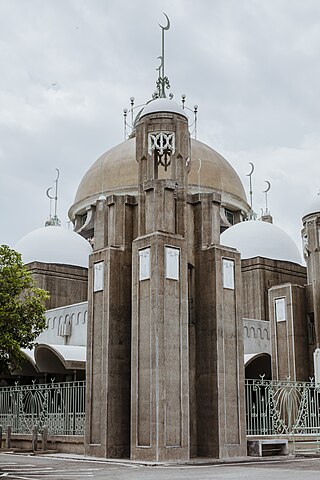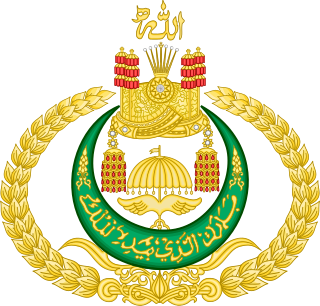
Muhammad Jamalul Alam II was the 26th Sultan of Brunei from 1906 until his death in 1924. His reign aimed to encourage new developments in agriculture, medicine, and education. Additionally, he also encouraged learning Islam and built a mosque despite the country's lack of revenue. During World War II, the mosque was destroyed due to the intense shelling and fighting within the towns in Brunei. His reign also oversaw Brunei during its most impoverished state.

Sultan Sulaiman Royal Mosque is Selangor's royal mosque, which is located in Klang, Selangor, Malaysia. It was constructed by the British in the early 1932 and was officially opened in 1933 by the late Almarhum Sultan Sir Alaeddin Sulaiman Shah.
Sultan Muhammad may refer to:

The Abidin Mosque is Terengganu's old state royal mosque built by Sultan Zainal Abidin II between 1793 and 1808. The mosque, which is also known as the White Mosque or the Big Mosque, is located in Kuala Terengganu, Terengganu, Malaysia. The old Royal Mausoleum is situated near the mosque.

Sultan Ismail Petra ibni Almarhum Sultan Yahya Petra was the 28th Sultan of Kelantan and the 11th Sultan of Modern Kelantan who reigned from 30 March 1979 to 13 September 2010. He succeeded on the death of his father, Sultan Yahya Petra. He was succeeded by his eldest son, Sultan Muhammad V who ascended to the throne on 13 September 2010 after Sultan Ismail Petra was incapacitated. Sultan Ismail Petra died at the Raja Perempuan Zainab II Hospital in Kota Bharu on 28 September 2019, aged 69, after 10 years of suffering from a massive stroke and was buried at the Kelantan Royal Mausoleum.

Seri Menanti Royal Mausoleum is a royal mausoleum of the Negeri Sembilan royal family located in the royal town of Seri Menanti, Kuala Pilah District, Negeri Sembilan, Malaysia. This mausoleum is located next to the Tuanku Munawir Royal Mosque.

The Abu Bakar Royal Mosque is Pahang's royal mosque which is located in Pekan, Pahang, Malaysia. It was officially opened in 1976 by Sultan Ahmad Shah of Pahang replacing the nearby Abdullah Mosque or Old Royal Mosque.
Muhyiddin ibni Abdul Jalilul Akbar was the 15th Sultan of Brunei and the fourth son of Sultan Abdul Jalilul Akbar. He took the throne after defeating his opponent, Sultan Abdul Hakkul Mubin during the Brunei Civil War. Notably, he also attempted to return the throne back to the origin bloodline via Sultan Muhammad Ali's family.
Muhammad Hasan ibni Saiful Rijal, posthumously known as Marhum di Tanjung, was the sultan of Brunei from 1582 to 1598. During him reign, the Bruneian Empire had full control of the island of Borneo and Northern Philippines, including Sulu.
Pahang Old Royal Mausoleum is a Pahang royal burial grounds at Kampung Marhum, Kuala Pahang, Pekan, Pahang, Malaysia.

The House of Bolkiah is the ruling royal family of Brunei Darussalam. It is composed of the descendants of the 1st sultan Sultan Muhammad Shah and his family. The Sultan of Brunei is the head of state and absolute monarch of Brunei. He is also head of government in his capacity as Prime Minister.

Kelantan Royal Mausoleum or Langgar Royal Mausoleum is a Kelantan royal burial ground located at Kampung Langgar near Kota Bharu, Kelantan, Malaysia.
Abdul Hakkul Mubin ibni Muhammad Panjang, posthumously known as Al-Marhum di Pulau, was the Sultan of Brunei from 1661 to 1673. He was involved in the Brunei Civil War and ruled the sultanate from 1661 to 1673, after killing his uncle, Sultan Muhammad Ali.

The Royal Brunei Mausoleum is a Royal Mausoleum of Brunei located at Jalan Tutong, Bandar Seri Begawan, Brunei. The Mausoleum is the main resting place and burial ground for several Sultans of Brunei and members of the Royal Family. The Royal Mausoleum was opened during the reign of Sultan Omar Ali Saifuddin I who later became the first monarch to be buried in the Mausoleum when he died in 1795.

The Sultanate of Sarawak was a Malay kingdom, located in present-day Kuching Division, Sarawak. The kingdom was founded in 1599, after the conquest of the preceding Santubong Kingdom and the later Sultanate of Brunei.

Kota Batu is a historical as well as populated area in Bandar Seri Begawan, the capital of Brunei. It is home to the Kota Batu archaeological site, a few of the country's museums and two mausoleums of the earliest Sultans of Brunei. However, the place is still populated and at present it is a neighbourhood of the capital.

Cermin Island is an islet at the mouth of Brunei River in the Mukim Kota Batu, Brunei-Muara District, Brunei. During the Brunei Civil War, a battle unfolded on the island and it's sometimes referred to as the Peperangan Pulau Cermin. A proposal for an 5 hectares protection status to be implemented on the island. The island is home to sundry vegetation and swamp forests.

Berambang Island is an island at the southern bank of the Brunei River in the Mukim Kota Batu, Brunei-Muara District, Brunei. The island was formerly named Buang Tawer during The Brooke Era from 1841 until 1941. The mausoleum of the 9th Sultan of Brunei, Sultan Muhammad Hassan is located on the island, near Kampong Sungai Bunga.
Muhammad Alam ibnu Muhammad Kanzul Alam was the self-proclaimed 22nd Sultan of Brunei. Due to his tough and strict attitude, he was given the Malay nicknames Raja Api and Sultan Marak Berapi. Despite being perceived as a fragile and progressively protective kingdom, Brunei managed to hold onto its lands under his rule, which stretched from Tanjong Datu in Sarawak to Kimanis in Sabah.














